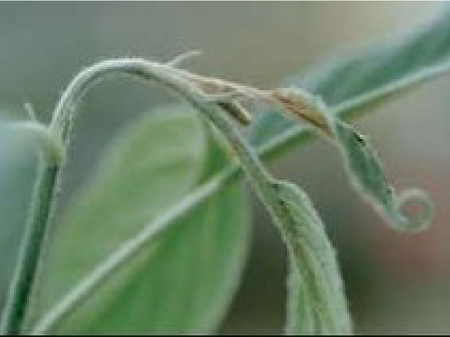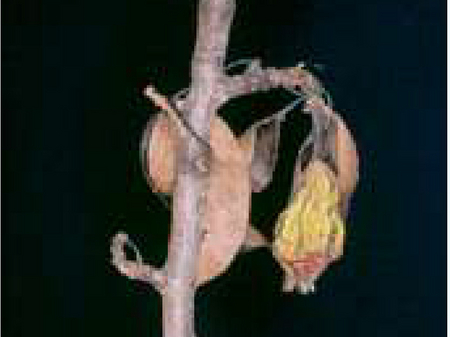Fire blight
Erwinia amylovora
Profile
Fire blight is a highly infectious, difficult-to-control disease of various fruit and ornamental trees of the rose family. The pathogen is a bacterium that leads to a brownish to black coloration of the affected plants and the discharge of sticky bacterial slime. Affected plants can die within a very short time.
Damage symptoms
Leaves and flowers of infected plants suddenly wilt and turn brown or black. Infected shoots initially appear pale green, dry out and turn brown to black. As a result of water loss, the tips of the shoots often bend downward in a hook shape. In damp weather, whitish drops of sticky bacterial slime emerge from the infested areas, later turning brown. This can also be found under the bark of freshly infested trees, the wood is usually reddish brown in color and interspersed with slime, which sometimes also breaks out of the bark.
Towards the end of the annual growing season, the spread of the bacteria comes to a halt. Diseased sections of bark sink in, creating a distinct boundary line between diseased and healthy tissue. During the winter, the dead leaves and shriveled fruits remain attached to the parts of the twigs that look like they have been burned. The starting point for new infections in spring are bacterial secretions that emerge from cancerous infestations on the perennial wood.





Propagation and transmission
After transfer to the shoots of susceptible host plants, the fire blight pathogen penetrates through natural openings (pores, stomata) or through wounds. The spread of the pathogen within a host plant is much faster in young shoots than in older ones. The first signs of dieback may become visible no earlier than four days after infection. Within two to three weeks, a young pear tree may be dead.
Particular risks for the further spread of the disease are posed by:
- Rain, hail, wind (causing small wounds).
- tools, shoes, hands, clothing, tires and machinery.
To prevent the introduction or spread of the disease with contaminated plant material, it is essential to know if the material comes from a fire blight-free area. Strict requirements must be followed when delivering fire blight host plants to protected areas.
Prevention and control
- Reduce infectious material as far as possible already before flowering.
- Regular inspections of leaves, flowers and bark during dry weather
- Avoid as far as possible in case of acute risk of infection:
- Plant protection treatments against animal or fungal pathogens
- Over-crown sprinkling
- Mechanical thinning
- Grubbing up or generous pruning as soon as possible (preferably within a few days after fire blight infestation has been detected)
- Closure/flaming of larger interfaces
- Immediate burning of uprooted or cut off infested plant parts (never leave open!)
- Avoid injury to healthy trees
- In case of strong slime formation, postpone sanitation
- In case of heavy infestation, no mechanical measures such as shaping and pruning (great risk of spreading bacteria)
- Always disinfect or flame cutting tools thoroughly!
- For plant protection products approved for the control of fire blight, please refer to the list of plant protection products approved in Austria.
Specialized information
We carry out detection of the fire blight pathogen in suspected plants or asymptomatic tissue and coordinate activities for strategic control.
Information on the current risk of infection can be found at thewarning service of the Austrian Chambers of Agriculture or at the official plant protection services of the federal states.
At regular intervals, we hold the Fire Blight Round Table, to which all stakeholders and experimenters/scientists concerned with fire blight in Austria are invited. It serves as a forum for the exchange of information on all fire blight topics, for the coordination and planning of various activities and for the dissemination of current research results.
Last updated: 10.10.2023
automatically translated